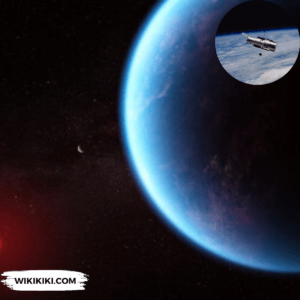NASA’s Hubble Space Telescope has detected water vapor in the atmosphere of the smallest exoplanet ever observed, GJ 9827d. This announced by the NASA Hubble Mission Team and the Max Planck Institute for Astronomy, opens a new chapter in our understanding of distant worlds and their potential for hosting water-rich atmospheres.

Also Read: Iran Successfully Launches Sorayya Satellite into 750 km Orbit
GJ 9827d, situated 97 light-years away from Earth in the constellation Pisces, has a diameter approximately twice that of our home planet.
The detection of water vapor on such a relatively diminutive celestial body challenges our preconceptions about the diversity of atmospheres on rocky exoplanets.
The observations, spanning three years and 11 transits, utilized the Hubble Telescope’s capabilities to analyze starlight passing through GJ 9827d’s atmosphere during its transits across its host star.
The spectral fingerprints of water molecules were identified, a leap in our ability to directly detect atmospheres on small exoplanets.
“This would be the first time that we can directly show through an atmospheric detection that these planets with water-rich atmospheres can actually exist around other stars,” said by team member Björn Benneke from the Trottier Institute for Research on Exoplanets at Université de Montréal.
“This is an important step toward determining the prevalence and diversity of atmospheres on rocky planets.”
Also Read: James Webb Space Telescope Discovers the Oldest Black Hole Ever
The newfound exoplanet presents astronomers with a tantalizing mystery. With a scorching surface temperature comparable to Venus at 800 degrees Fahrenheit, GJ 9827d challenges our understanding of planetary compositions. Two possibilities emerge from this discovery.
One posits that the planet clings to a hydrogen-rich atmosphere laced with water, resembling a mini-Neptune.
Alternatively, it could resemble a warmer version of Jupiter’s moon Europa, where half the planet could be composed of water and the other half of rock. The presence of water vapor at such high temperatures is a discovery that propels our quest to characterize truly Earth-like worlds.
Co-principal investigator Laura Kreidberg of the Max Planck Institute for Astronomy commented, “Water on a planet this small is a landmark discovery.
It pushes closer than ever to characterizing truly Earth-like worlds.” However, the team acknowledges the need for investigations to discern whether the atmosphere is dominated by water vapor or if it’s a mere trace in a hydrogen-dominant atmosphere.
Also Read: Japan’s Moon Sniper Attempts Lunar Landing, After 2 Failures
Water, often considered the universal solvent and an ingredient for life as we know it, sparks curiosity about the habitability of GJ 9827d.
While its extreme temperatures currently render it inhospitable, the discovery of water vapor invites contemplation about the conditions necessary for life on other distant worlds.
The Hubble program’s observations have set the stage for future studies. The James Webb Space Telescope (JWST), NASA’s upcoming infrared observatory, is to delve deeper into GJ 9827d’s mysteries.
With capabilities for infrared observations, JWST plans to identify carbon-bearing molecules like carbon monoxide, carbon dioxide, and methane, providing an inventory of the planet’s elements and aiding in understanding its formation.
Thomas Greene, an astrophysicist at NASA’s Ames Research Center, said the importance of water detection, stating, “Observing water is a gateway to finding other things.” The Hubble’s discovery opens the door to a more detailed examination of GJ 9827d.
GJ 9827d, initially discovered by NASA’s Kepler Space Telescope in 2017, completes an orbit around its red dwarf star every 6.2 days. The star, GJ 9827, located 97 light-years from Earth.
Also Read: NASA and Lockheed Martin Unveils X-59 Quiet Supersonic Aircraft























